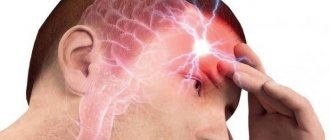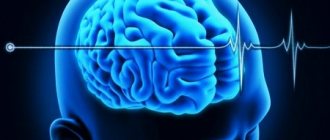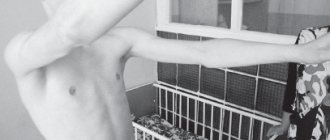Vegetative-vascular dystonia: “mysteries” of diagnosis
Over the years, attitudes towards the diagnosis of VSD have changed both among doctors and patients. Together with a neurologist of the highest category, candidate of medical sciences, head of the consultative and diagnostic department of the clinic of the Federal State Budgetary Institution "Research Institute of Therapy and Preventive Medicine" SB RAS Svetlana Duma, we decided to debunk the myths with which this disease is associated today.
Vegetative-vascular dystonia is indeed a fairly new phenomenon. Knowledge of the autonomic nervous system was first developed only in the twentieth century by academician Alexander Wein. However, today 80% of patients who consult a neurologist have a disorder that doctors characterize as vegetative-vascular dystonia. At the same time, the number of such patients is growing rapidly, and antidepressants, which are used to treat VSD, have long taken first place among the best-selling medications. During the short history of its existence, a clear understanding of this disease has not emerged among patients.
Myth 1.
VSD is a vascular disorder.
In fact
This is an imbalance of all organs and systems for the coordination of which the autonomic nervous system is responsible.
According to the definition of Alexander Wein, VSD is a violation of various functions of the body, usually somatic, that is, physically tangible. The cause of these disorders is a failure in the nervous regulation carried out by the autonomic nervous system. It is she who is responsible for synchronizing the processes occurring in the internal organs.
Myth 2.
The cause of VSD is a chronic disease.In fact
Chronic disease can trigger VSD in older people, but in most cases the cause of VSD is a nervous disorder.
Another exception is adolescents whose hormonal levels change during puberty, as well as people with endocrine pathologies. And yet, according to neurologists, only 20% of patients with vegetative-vascular dystonia have a primary pathology of any organ or system.
“In middle-aged and older people, indeed, VSD can develop against the background of some kind of somatic disease
, says Svetlana Duma.
– This could be pathology of the gastrointestinal tract, vascular diseases of the heart or brain, neurodegenerative diseases, consequences of injuries and infections.
But if we talk about the most common cause of VSD, then these are neurotic disorders - anxiety or anxiety combined with depression.” One of the most complex manifestations of VSD, which has developed on a nervous basis, is panic attacks, that is, sudden inexplicable attacks of fear, accompanied by bodily discomfort. As a rule, these symptoms occur when the patient delays treatment of the pathology without recognizing its psychological, or rather psychiatric, nature.
Myth 3.
There is no diagnosis of VSD.In fact
There is such a diagnosis in disease classifiers, but it is not in its “right” place, hence its “non-existence”: the diagnosis is indeed not somatic, but it is not officially classified as a nervous disease.
Since the true cause of most cases of VSD is a disorder of a nervous nature, in the classification of diseases it, logically, should belong to the section of nervous diseases.
However, due to established practice, the diagnosis of VSD is located among somatic (bodily) diseases. According to doctors, the reason for this discrepancy is that patients with vegetative-vascular dystonia are in no hurry to turn to psychiatric specialists.
“If we exclude an organic cause, we diagnose VSD on the background of an anxiety disorder, although the anxiety disorder comes first here
, says Svetlana Duma.
– If such a patient gets to a psychiatrist or psychotherapist, he will be given, in fact, the correct diagnosis. This will be, for example, a somatoform or anxiety disorder, due to which VSD syndrome develops. This bureaucratic discrepancy is apparently due to the fact that people do not want to go to the right doctor.”
Myth 4.
A doctor may miss a serious disease by diagnosing VSD.In fact
The patient is always carefully examined, even if he is “recognized” as a patient with VSD.
The diagnosis of VSD is made by exclusion. This means that when examining a patient with suspected vegetative-vascular dystonia, all possible somatic pathologies are excluded.
“Experienced neurologists immediately see a patient with VSD, but they cannot take upon themselves the responsibility of diagnosing him without additional examinations,
– explains the doctor.
– We look at the probable objective cause that is causing the problem, and if we do not confirm it, we make a diagnosis of “VSD.”
The patient's examinations include a health check according to a certain standard, which includes an ECG and a blood test. In addition, the patient’s endocrine system is checked - the condition of the thyroid gland, pituitary gland, hypothalamus and adrenal glands.
Myth 5.
VSD is the second name for another disease.In fact
Other names for VSD are related to the fact that at one time they tried to rename this diagnosis, but now it has no official synonyms.
“We have a variant of the diagnosis that, in general, has become obsolete - neurocirculatory dystonia
, says Svetlana Duma.
– It implies slight fluctuations in pressure, minor rhythm disturbances. Now this diagnosis is not made; instead, VSD is given. They tried to rename VSD, for example, there was a syndrome of vegetative dystonia, Alexander Moiseevich Vein proposed “psycho-vegetative syndrome.” The name may vary, but the classification remains “VSD”.
Myth 6.
Symptoms of VSD are concentrated in the head area.In fact
Symptoms can manifest themselves both from the gastrointestinal tract and as pain in the chest.
Neurologists call VSD a multisystem diagnosis: the disorder attacks the patient from an unexpected direction, and sometimes from several sides at once. A patient with VSD may complain, for example, of pain in the heart area, but when questioning the doctor, it turns out that he has been tormented by intestinal problems for a long time, chills appear inappropriately, and sometimes his body temperature fluctuates.
“Very often, patients with VSD complain of pain, from different sides. One of the variants of autonomic dysregulation is functional disorders of the gastrointestinal tract,
— says Svetlana Duma.
– In recent years, they have been encountered so often that gastroenterologists have identified them as a separate category. In the 19th century, these disorders were called intestinal neurosis; now they are functional disorders of the gastrointestinal tract.”
Myth 7.
VSD is a congenital pathology, and at the same time “lifelong”.In fact
VSD is usually acquired in a stressful situation, and it is possible to get rid of dystonia with proper treatment.
According to the doctor, the success of treatment depends on individual “brain chemistry.” As a rule, treatment is quite long, but it does not last for the rest of your life. At the same time, the disease can catch a person, as they say, out of the blue, because almost everyone is exposed to stress today. But it is a stressful situation that often becomes a trigger for symptoms of VSD.
“In the 90s in Novosibirsk there were small echoes of the earthquake, to which many residents reacted with fear and deterioration in health,
- the doctor recalls.
– Then a whole layer of so-called vegetatives went to neurologists.
Sometimes in a stressful situation a person mobilizes and copes with the problem, sometimes very successfully. Often after such situations an anxiety disorder occurs because the body is overstressed and is unable to relax.” How to treat?
Unfortunately, a patient with VSD due to a nervous disorder today is in a difficult situation. On the one hand, he should contact a psychiatrist, but specialists in mental illness, as a rule, do not find sufficient grounds for treatment. The services of their alternative, psychotherapists, are usually not cheap. However, in not very advanced cases, patients with a disorder of the autonomic system can be helped by a neurologist or therapist. According to the doctor, it is they who see the vast majority of such patients.
“In Soviet times, therapists were turned into psychotherapists, but now, of course, there is no such thing,
– says Svetlana Duma.
“ But today a therapist can prescribe first-line antidepressants, which are allowed for everyone.
In this case, it is the nervous disease that needs to be treated – anxiety or anxiety-depressive disorder. We can prescribe mild medications that stabilize autonomic activity, but if the nervous disorder is not treated, after some time all the symptoms will return.”
Prevention of vegetative-vascular dystonia
But prevention of nervous VSD is simple. If it is hardly possible to protect yourself from stress in modern conditions, then everyone can prevent nervous overexertion, the doctor assures. To do this, you just need to set aside some time for rest every day and during the week.
“The body is like a spring; if you constantly strain it, it will react in the form of imbalance,” says Svetlana Duma. – It is also important to learn to enjoy the little things. If a person knows how to have fun every day, that’s great – it improves his health.”
Related articles:
Under the pressure of depression
Panic attacks: silent horror
Nutrition correction
Proper nutrition should become a habit for every person suffering from vegetative-vascular dystonia. The diet should be balanced; it is recommended to eat 300-400 g of vegetables and herbs per day, but do not overuse fruits (1-2 per day or 1 glass of berries). Nutritionists advise giving up large portions of food and giving preference to fractional meals (small but frequent portions). Optimally, eat food 5-6 times a day, every 2.5-3 hours.
The following should be excluded from the diet:
- fatty, fried and highly salted foods;
- sausages;
- semi-finished products;
- carbonated and alcoholic drinks.
The best way to cook food is stewing, boiling and baking.
The diet should consist of foods rich in vitamins and minerals involved in the synthesis of connective tissue fibers:
- whole grain products;
- fermented milk products;
- lean meats;
- fish and seafood;
- raw vegetables and fruits.
Especially useful are foods containing large amounts of vitamin E, a vitamin that increases the elasticity of blood vessels and prevents blood clots:
- vegetable oils;
- beef liver;
- eggs;
- soy;
- legumes;
- nuts;
- avocado.
Traditional medicine recipes
Traditional medicine will help reduce the manifestations of vegetative-vascular dystonia and strengthen the blood vessels of the brain.
- Herbal decoctions. You can achieve good results by using herbal decoctions based on motherwort, rose hips, hawthorn, rowan and cudweed. Fruits and herbs are poured with boiling water and infused for several hours.
- Decoction of bay leaf. To increase the elasticity of blood vessels, you need to prepare the following decoction: pour 5-6 bay leaves with a liter of water, bring to a boil and simmer for 3-4 minutes. The decoction is drunk in small sips throughout the day.
- A mixture to strengthen blood vessels. To prepare the mixture, you need to take dried apricots, prunes, lemon and walnuts and grind them through a meat grinder. Then the mixture is poured with honey and mixed thoroughly. The mixture should be taken in the morning and evening after the main meal.
Cold and hot shower
Regular contrast showers will help strengthen vascular walls and increase blood circulation. When the temperature changes, the vessels begin to contract and then expand. This is literally a charge for the blood vessels.
During the first procedures, getting into a cold shower can be quite difficult. Therefore, you can start with contrasting foot baths. For this purpose, you need to stock up on two basins with hot and cold water and alternately move your legs from one basin to another at intervals of 1-2 minutes.
It is important to note that, unlike a contrast shower, visiting hot baths and saunas is not a means of strengthening blood vessels and may even be contraindicated in case of thin vascular walls.
Physical activity
Regular physical activity helps normalize metabolism and the penetration of oxygen through the vessels directly into the brain. At the same time, sports should not be too intense. Moderate but regular activity is sufficient.
The following sports are ideal for vascular health:
- race walking;
- cycling;
- swimming;
- yoga;
- gymnastics.
These sports will charge you with energy and increase blood circulation.
Experts advise people under 40 to walk 12 thousand steps a day, and for people aged 40+ – 10 thousand steps. It is convenient to control this if you install special pedometer applications on your smartphone.
Maintaining a daily routine
With VSD, it is very important not to expose the body to stress and overwork. To do this, you need to ensure yourself a daily 7-8 hour sleep, as well as 30-40 minute rest breaks on the working day. Japanese scientists have shown that a 26-minute nap between 1 p.m. and 3 p.m. during the day has a positive effect on the condition of blood vessels and significantly reduces the risk of stroke.
This study found that sleeping too much is harmful. Sleeping more than 6 hours at night reduces your health.
To prevent stress, you should try to avoid conflict situations at work and at home, set aside time for relaxation, walks in the fresh air, and doing what you love.








